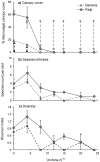Phase-Shift Dynamics of Sea Urchin Overgrazing on Nutrified Reefs
- PMID: 28030596
- PMCID: PMC5193397
- DOI: 10.1371/journal.pone.0168333
Phase-Shift Dynamics of Sea Urchin Overgrazing on Nutrified Reefs
Abstract
Shifts from productive kelp beds to impoverished sea urchin barrens occur globally and represent a wholesale change to the ecology of sub-tidal temperate reefs. Although the theory of shifts between alternative stable states is well advanced, there are few field studies detailing the dynamics of these kinds of transitions. In this study, sea urchin herbivory (a 'top-down' driver of ecosystems) was manipulated over 12 months to estimate (1) the sea urchin density at which kelp beds collapse to sea urchin barrens, and (2) the minimum sea urchin density required to maintain urchin barrens on experimental reefs in the urbanised Port Phillip Bay, Australia. In parallel, the role of one of the 'bottom-up' drivers of ecosystem structure was examined by (3) manipulating local nutrient levels and thus attempting to alter primary production on the experimental reefs. It was found that densities of 8 or more urchins m-2 (≥ 427 g m-2 biomass) lead to complete overgrazing of kelp beds while kelp bed recovery occurred when densities were reduced to ≤ 4 urchins m-2 (≤ 213 g m-2 biomass). This experiment provided further insight into the dynamics of transition between urchin barrens and kelp beds by exploring possible tipping-points which in this system can be found between 4 and 8 urchins m-2 (213 and 427 g m-2 respectively). Local enhancement of nutrient loading did not change the urchin density required for overgrazing or kelp bed recovery, as algal growth was not affected by nutrient enhancement.
Conflict of interest statement
The authors have declared that no competing interests exist.
Figures




References
-
- Posey MH, Alphin TD, Cahoon LB, Lindquist DG, Mallin MA, et al. (2002) Top-down versus bottom-up limitation in benthic infaunal communities: Direct and indirect effects. Estuaries 25: 999–1014.
-
- Burkepile DE, Hay ME (2006) Herbivore vs. nutrient control of marine primary producers: Context-dependent effects. Ecology 87: 3128–3139. - PubMed
-
- Beisner BE, Haydon DT, Cuddington K (2003) Alternative stable states in ecology. Frontiers in Ecology and the Environment 1: 376–382.
-
- Collie JS, Richardson K, Steele JH (2004) Regime shifts: can ecological theory illuminate the mechanisms? Progress in Oceanography 60: 281–302.
-
- May RM (1977) Thresholds and breaking points in ecosystems with a multiplicity of stable states. Nature 269: 471–477.
MeSH terms
LinkOut - more resources
Full Text Sources
Other Literature Sources
Medical
Miscellaneous

